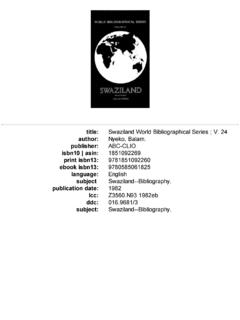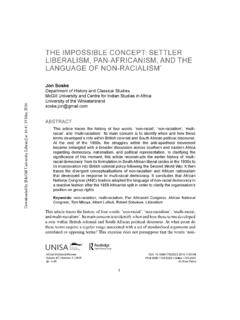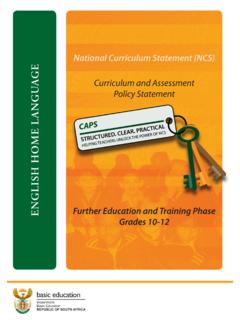Transcription of Commentary The ‘Hani Memorandum’ – introduced and …
1 TRANSFORMATION 69 (2009) ISSN 0258-7696106 CommentaryThe Hani memorandum introduced andannotated1 Hugh Hani memorandum , a document produced and signed by Chris Haniand six other members of the African National Congress (ANC) s armed wingUmkhonto we Sizwe (MK) early in 1969, following the failure of the Wankieand Sipolilo campaigns, is frequently cited but there appears to be nocomplete copy in a public archive. It has been published only once and thatwas 30 years ago in an obscure exile journal without identification, date,context, or the names of the signatories not surprisingly, it seems then tohave passed In his book ANC: A View from Moscow VladimirShubin (1999) provides an accurate summary of the memorandum s contents,but the copy to which he had access in the Soviet archives seems to havebeen produced for circulation to the diplomatic community and containedno names and no unavailability of the memorandum has not prevented its continuedcitation for political purposes and it is still influential 40 years after itsproduction.
2 Speaking at the launch of the Chris Hani Municipality s LiberationHeritage Route at Hani s birthplace, Sabalele, near Cofimvaba in the EasternCape on April 10, 2008, the 15th anniversary of his death, the ANC s thenrecently elected secretary-general, Gwede Mantashe, who was also chairmanof the South African Communist Party (SACP), made intriguing use of theHegelian/Marxian dialectic thesis, antithesis and synthesis to link threemajor conferences in the history of the ANC: morogoro (1969), Kabwe(1985), and Polokwane (2007). Drawing a parallel between the three, he saweach of them as coming after a period of dissatisfaction with the leadership,if not actual mutiny, as providing an opportunity to confront and to discussthe outstanding issues, and as heralding a period of reform and : the Hani memorandum Mantashe acknowledged that it was the Hani memorandum , and indeedmutiny, that led directly to the morogoro More recently, TerryBell cited the memorandum in an article in which he argued that the presentcrisis in the ANC had its roots in its exile history.
3 Zola Skweyiya, thenminister of social welfare in South Africa, cited the memorandum in yetanother context, referring to the danger of Xhosa or Nguni dominance of theANC, and looking back to what was sometimes seen as a mutiny of Capemen .5 There are no precise figures, but about 50 MK men with a smaller numberof ZAPU (Zimbabwe African Political Union) combatants took part in theWankie campaign, which was launched across the Zambezi from nearLivingstone in western Zambia at the end of July 1967. The ANC s LuthuliDetachment was divided into two main groups the western group wasintended to move through Rhodesia to South Africa. A second group splitoff from the first in the Wankie Game Reserve and moved eastwards with theintention of establishing bases with ZAPU in northern and central Rhodesiaas part of a Ho Chi Minh Trail to South Africa.
4 Five months later inDecember 1967 a second offensive, the Sipolilo campaign, was launchedfrom eastern Zambia its objectives were not clear-cut. The MK membersof this Pyramid Detachment suffered heavy casualties 23 died. 6Of the MK members who fought in the Wankie campaign about 25 werekilled in action, about a dozen were captured and served long prison termsin Rhodesia or South Africa, and the remainder, including a small groupunder the leadership of Chris Hani, a political commissar, made a strategicwithdrawal into Botswana where they were arrested, charged and second group of MK and ZAPU men crossed into Botswana a few As a result of pressure from various sources, including the OAU andits liberation committee, and of negotiations with the Zambian government,these men were deported to Zambia in 1968-9 after spending a year or morein prison in Gaborone.
5 It is difficult to be precise about dates because, forsecurity reasons, prisoners who were deported from Botswana by air weregiven passports under false names these were different from their MKnames - but Hani, who had been arrested in August 1967, probably returnedto Lusaka with a few others in the second half of December drafting of the Hani memorandum Although they were given a welcome-home party by Jack and Ray Simonsat their house at 250 Zambezi Road, Lusaka, they were shocked by the lack108 Hugh Macmillanof any kind of official welcome by the leadership and by its failure to debriefthem with a view to learning any lessons that could be drawn from thecampaign. Sometime in 1970 Hani Comrade Chris told an internalcommission of enquiry into later incidents in Lusaka that after leavingprison in Botswana he found the movement in a stalemate position.
6 Therewas no longer any direction, there was general confusion or an unwillingnessto discuss the lessons of the revolution .9It was in this volatile situation that the document that came to be knownas the Hani memorandum was produced, probably in January 1969. Accordingto a second memorandum , detailing the background of the first, and producedin March 1969 by Chris Hani and the other signatories, with the help of JackSimons, indicating their grounds of appeal against expulsion, they had notoriginally intended to write a memorandum at all. They had delegated threeof their number to interview the secretary-general, Duma Nokwe, 10 with aview to arranging a discussion with members of the Executive . Nokwe tookup a hostile attitude, maintained that the issues we had raised were trivial,and proposed to interview us individually and not as a group.
7 We consideredthis procedure to be un-political and refused to comply. Nokwe causedparticular offence by failing to recognise one member of the deputation,Jackson Mlenze, a Wankie veteran, and the commander of a unit that wasintended to reach the Transkei. They, on the other hand, incensed Nokweby their suggestion, repeated in the memorandum , that Amiran, an Israeliagricultural equipment company, for which his wife, Vuyiswa (Tiny), wasthen working was a front for Israeli Nokwe told ourrepresentatives to arrange a meeting with members of the Executive .The Commissariat eventually sanctioned a meeting with the NEC and sixmembers were present when this took place. The delegates had prepared astatement and they were told to have this typed and to provide copies to allmembers of the executive who were then present.
8 The memorandum , which made a political analysis and attributed all the weaknesses we complainedof to political and personal failings of some of our leaders , was then typed,stencilled and duplicated in the ANC office and copies were provided tomembers of the executive and to selected members of MK . The latter were cautioned to treat the matter as highly confidential and in no circumstancesto disclose its existence to people who did not belong to the organisation. 12In addition to Hani, who signed as M. T. Hani (Chris) ,13 the six othersignatories to the memorandum were (Jeqe) Mbengwa,14 LeonardPitso,15 later a general in the South African National Defence Force,109 Debate: the Hani memorandum Ntabenkosi Fipaza (Mbali),16 Wilmot Hempe,17 Tamana Gobozi (Mikza),18 andG.
9 S. Mose (Jackson) Only two of the signatories, Hani and Mlenze,were members of the Luthuli Detachment who had fought in the Wankiecampaign and been imprisoned in Botswana. Two others had crossed theZambezi and entered Rhodesia in connection with the campaign one of thelatter was Fipaza (Mbali) who served as a medical officer, the other may havebeen Leonard Pitso. The signatories were sometimes referred to as the Capegroup , implying a Xhosa identity, though at least two of them came fromother provinces Mbengwa (Buthelezi) from Natal and Pitso from theTransvaal. According to Walter Msimang (Mavuso), the memorandum didnot have widespread support. He says that he was one among many whowere suspicious of what he says was the involvement of TennysonMakiwane20 in its composition, a suggestion that Makiwane Major-General Gardner Sijake and Alfred Sipetho Willie take a different view.
10 Theysay that the memorandum had widespread support and that the sevensignatories were chosen as representing a much larger group, Hani was staying at the time, at the request of the ANC leadership,in the house of Livingstone Mqotsi,23 a leading, though by then an expelled ,member, of the Unity Movement he had clashed with IB Tabata. It wasalleged that he too had a hand in the drafting of the memorandum , but herefutes that suggestion and says that he knew nothing about it until a copywas thrust into his hands by Mzwai Piliso,24 who came to see him one dayat midnight, and begged him to use his influence with Hani and the boys and persuade them to apologise for In his last interview, Hani tookpersonal responsibility for the writing of the memorandum and there is noreason to doubt that he was the primary, though not the sole, reaction to the Hani memorandum The signatories at their next meeting with the executive, following theproduction of the memorandum .











